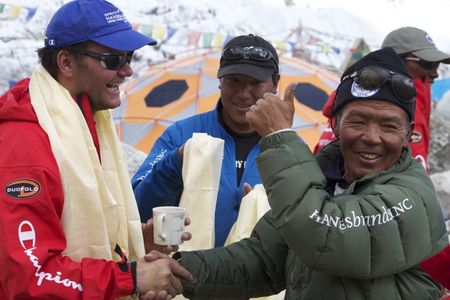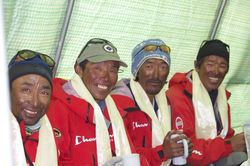
, , and the five climbing Sherpas–Kami Tsering, Arita, Ang Namgal, Pemba Dorje, and Sonam–of , reached the summit of Mount Everest on May 17, the early side of a season that has so far seen high winds, slim summit windows, and at least 300 climbers ascending from the Nepal side alone. Combine the weather, crowds, and the tactical maneuvers required for a successful summit of the world’s highest mountain and you’re guaranteed a few surreal moments. A few interesting scenes from Clarke and Simper’s climb:
Starting out:
Simper: We left Base Camp on May 12 at approximately 4 in the morning.
Clarke: It was a very cool start. They put a lot of kerosene on the puja, I loved that.
Simper: We were both feeling good that day. But we had been sitting in base camp for over two weeks. We moved up through the icefall.
Clarke: We were relieved to be through the icefall, but when we topped out, the wind hit and it was like 30-40-mile constant and it was in your face and it was freezing.
Camp II:
Simper: We felt really good that day when we got there, but you’re always 12 hours ahead of your symptoms. I was good until about 1 o’clock in the morning, and then I had a splitting headache. The next thing you know, I had my head out the vestibule and I was throwing up. The next day I was so dehydrated that I was drinking some of that Clark Fosters orange drink and sitting in the cook tent with the guys, then running out and just projectile spewing orange vomit all over the side of the hillside.
Clarke: That was a sad start to our summit push. Here we are at Camp II on our summit push and we already feel awful.
Simper: Where do we go from here? We rested, hydrated, hung out, next day we took a crack at Camp III, and it got worse. Tactical error: The Sherpas thought it was going to be hot, so we thought we’d just be fine to go up in our Gore-Tex shells.
Clarke: I haven’t been that cold in a long, long, long time. My brain was like, dude, you are getting dangerously cold.

Simper: By the time we got to the tent I was down to three steps. I remember thinking: no mistakes because you’re not roped up.
Clarke: It was a typical mountaineering situation where you get yourself into a problematic situation. We made five or six or seven not great decisions. All these little decisions and, boy, we almost paid the price.
Simper: It could have been the end of the trip right there. Stayed up till 11 trying to boil water. But then we got up and it was a beautiful day, sunny…
Clarke: We were, like, two new dudes.
Simper: We were looking at the hill and there was, like, 80 people in front of us walking up the hill.
The Dead Body:
Simper: After Camp III we had gone through the yellow band, then on the next long traverse. Then I see these guys, like, three Sherpas, full on carrying what at first I thought was a couple of backpacks, or haul bags, but it was a lot of weight and you could see the fixed lines bending out. I clip in and the next thing you know it’s these Sherpas coming down with this Russian gentleman who perished on the Lhotse face the week before. It was just this frozen-stiff, rigid body. They had the hood all pulled around his face. I couldn’t help but think, Here this guy is going down and here I am going up. Could I be coming down like this guy? It was bizarre. He didn’t look peaceful to me. He looked frozen.
Clarke: And all tied up. He was wrapped up like Gulliver, that big giant. I was just going to try to get by. It was steep and awkward and the next thing you know I was grabbing the guy. I had my arm on him…oh, it was awful.
Simper: I remember looking back and you were holding on to his frozen arm.
Clarke: It was a handhold! Of all the days to bring a frozen dead man down, why that day when there were 80 people hanging on those anchors?
Simper: They put a lot of people’s lives at risk. If one of the bolts on the Yellow Band would have snapped, we all would have gone down.
Camp IV:
Clarke: We’re finally at camp IV, 26,000 feet, the last camp on the mountain thinking about when we’re going to go for our summit push.
Simper: I remember just laying in our tent when we first got there and just the wind hitting the tent, then you could hear, it sounded like sleeping next to a huge rapid.
Clarke: The Col’s always windy, you could hear that freight train river passing by. It’s not very nice when you’re in the tent when it’s really windy. It’s like a boxer punching you in the back of the head. The Sherps were bailing and we thought, Well, maybe we should get the hell out of here. But let’s just wait and see, wait and see.
Simper: The next day [the team spent two nights at Camp IV] it was clear and nice. It was summit day.
Clarke: The wind was slow enough so that it was a good call. We endured the day, got up at noon, took some pictures.
Simper: I remember climbing out of the tent at Camp IV and 15 more tents had moved in.
Clarke: Basically at that point we decided no matter what, we’re going to try because we can’t stay any longer. No matter what, that night we were going for it. We knew that night we were going for it. So that was actually kind of peaceful.
Summit Night:
Simper: We got up, climbed out of the tent at about 10 p.m. I remember looking up on the mountain and it looked like a ski resort at the torch relay they do on New Year’s. There was just, like, this snake of lights, of probably 80 people in front of us that had left at 6 o’clock. I couldn’t believe it. Then it was the anxiety rush, Oh my god, we’ve got to get up there.
Clarke: It wasn’t like that in 1997. That year we just fanned up on the triangular face and you just sort of soloed on your own.
Simper: So there’s all these people with their personal Sherpas who can’t even clip an anchor and have to have their personal Sherpa take their carabiner off to clip it. I can’t believe all these people are here that have no business being here that don’t know how to climb, who’ve paid their money.
Clarke: The fun part was, if you saw an opportunity coming up to pass, we’d bend down, turn each other’s oxygen up, and punch pass.
Simper: I don’t think we were making friends on the way up.
Clarke: It was like NASCAR about when to go get tires, when to change gas…
Simper: We went up another half hour, and then that’s where it really bottlenecked, because you come to the first moderate technical section of getting around these rocks, and some people had no idea to get up these rocky sections.
Clarke: The good thing about going so slow was: a) You could drink and eat, b) you had a lot of great photos.
Simper: For me that was the most magical spot of the whole climb: Dawn, that purple band across the sky, but from where we were you could actually see the curvature of the earth.
Clarke: The horizon bending away, and down to the left you could see the lights of Tengboche.
Simper: It was gorgeous. Then the sun broke and all the tops of the peaks lit up, which is good because everybody was yelling and was, like, hurry up.
The Summit:
Simper: We topped out on the summit at 8:40 on May 17. There it was, like a chorten kind of thing, wrapped in prayer flags, guaranteed to get tangled in your crampons when you’re trying to move around.
Clarke: It was pretty spectacular.
Simper: One thing I do remember is a bird. I did see a bird at the summit. A little brown finch thing. I had no idea birds went that high.
The Descent:
Clarke: I remember walking off and just trying to be like a sponge and soak it in, taking one big old 360 pan, looking at it all. I’m looking down the valley and Ama Dablam is just a little tiny mountain in the distance.
Simper: It’s funny, most of my life climbing to the top of mountains. But to think that you are the one place on the planet where there’s absolutely nothing for a very long way that is even close to being as tall as where you’re standing. It hit me hard.
Clarke: I was thinking of family, mostly.
Simper: On the way down I was thinking, OK, no mistakes, get off the mountain as fast as you can. We came down, it started to snow, and it’s like, OK, our weather window is gone. We gotta get out of here.
Clarke: I couldn’t tell the difference between the cornice by the Hillary Step and the sky. I was reaching out trying to find the cornice.
Simper: We had enough oxygen so we decided to spend one more night above 8,000 meters, which is pretty unheard of. But the one thing that we didn’t really realize is that we were all out of food. We had no more food.
Clarke: Not true. We had salt and water. We had soup, Yeti Soup.
Simper: A couple of bullion cubes and a pound of water split between seven guys. Then we got up in the morning and had hot water. It has a lot of minerals in it. Then we broke camp down and headed down. I remember that long traverse from Camp IV, the mountain looked so beautiful. It was bittersweet to leave, it had taken so much to get here. We got past all these people, got back to Camp III, where we actually had a bunch of food.
Clarke: Food that I forgot to bring to Camp IV. It was my responsibility.
Simper: And everybody dived on this bag of food like a flock of seagulls on a trash pile.
Simper: The one thing I’m really going to miss: the camaraderie that we had with our Sherpas. It was really a special honor to get to be part of that for a while.
Back at Base Camp:
Clarke: It was ultimately in my mind the day we were going for. Who knows what would happen on the summit? I knew we would try multiple times, I knew that we would not give up, but I couldn’t guarantee that we would make it to the summit. It was always about that last day when you made it through the icefall, when you walk through it the last time.
Simper: Rolling back into Base Camp was like, It’s over, we did it. You can climb to the top of the mountain, but you have not climbed a mountain until you are back down at the bottom of the mountain. At that moment I was like, phew.
Clarke: At that moment I was relieved. The promise we made to our families: Don’t worry about dad, we’ll be back, I promise. That’s when the promise was kept.
–Stephanie Pearson